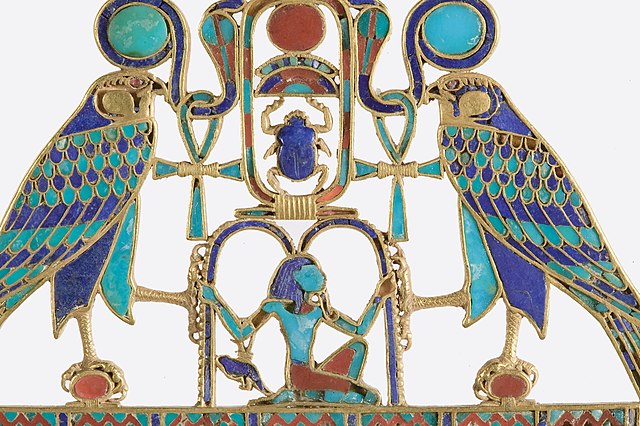The pectorals of ancient Egypt were a form of jewelry, often in the form of a brooch. They are often also amulets, and may be so described. They were mostly worn by richer people and the pharaoh.
Senusret II's pectoral, by 1878 BC. Hieroglyphs: Ankh, Huh (god)-(=millions), Shen ring, scarab, Ra, Water Ripple, Sun-rising hieroglyph, uraeus
Brooch pectoral, with hieroglyphs: uraeus, mut, Djed pillar, shen ring, naos (shrine) cartouche: adze, was scepter, sun disk, Maat hieroglyph, N-water ripple (n hieroglyph)
Amulet pendant from the tomb of Tutankhamun, with wadjet
Louvre statue with pectoral
Cloisonné is an ancient technique for decorating metalwork objects with colored material held in place or separated by metal strips or wire, normally of gold. In recent centuries, vitreous enamel has been used, but inlays of cut gemstones, glass and other materials were also used during older periods; indeed cloisonné enamel very probably began as an easier imitation of cloisonné work using gems. The resulting objects can also be called cloisonné. The decoration is formed by first adding compartments to the metal object by soldering or affixing silver or gold as wires or thin strips placed on their edges. These remain visible in the finished piece, separating the different compartments of the enamel or inlays, which are often of several colors. Cloisonné enamel objects are worked on with enamel powder made into a paste, which then needs to be fired in a kiln. If gemstones or colored glass are used, the pieces need to be cut or ground into the shape of each cloison.

Pectoral of Senusret II, from his daughter's grave, using shaped stones rather than enamel. Cloisonné inlays on gold of carnelian, feldspar, garnet, turquoise, lapis lazuli, 1880s BC
Chinese Ming Dynasty cloisonné enamel bowl, using nine colours of enamel
Early 7th century Anglo-Saxon seax (knife) hilt fitting, gold with garnet cloisonné inlay. Staffordshire Hoard, partially cleaned.
Byzantine cloisonné enamel plaque of St Demetrios, c. 1100, using the senkschmelz or "sunk" technique and the new thin-wire technique








